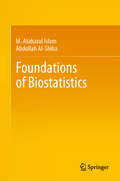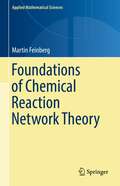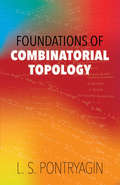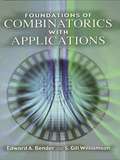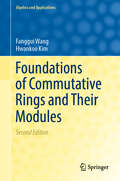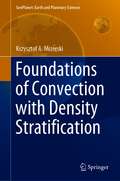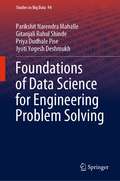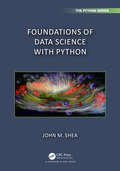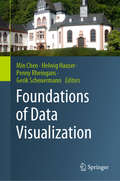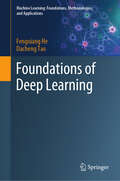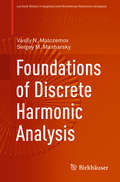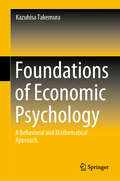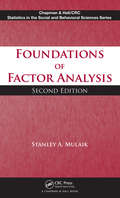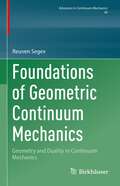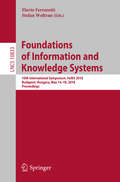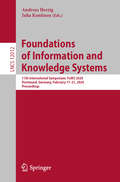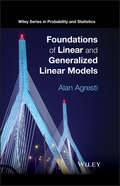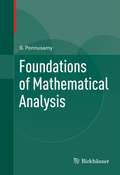- Table View
- List View
Foundations of Biostatistics
by M. Ataharul Islam Abdullah Al-ShihaThis book offers a comprehensive guide to essential techniques and methods in biostatistics, addressing the underlying concepts to aid in comprehension. The use of biostatistics techniques has increased manifold in the recent past, due to their suitability for applications in a wide range of problems in various fields. This book helps learners grasp the materials in detail, equipping them to use biostatistics techniques independently and confidently. The book starts with a summary of background materials, followed by methods and techniques. As such, with only minimum guidance from teachers, this book can provide materials for self-learning of biostatistics techniques with a deeper level of understanding. The first two chapters focus on fundamental concepts, sources of data, data types, organization of data, and descriptive statistics, followed by the basic probability concepts, distributions and sampling distributions needed in order to combine descriptive statistics with inferential techniques. Estimation and tests of hypotheses are illustrated in two separate chapters. Important measures of association, linear regression, analysis of variance and logistic regression, and proportional hazards models are then presented systematically, ensuring that the book covers the topics most essential to students and users of biostatistics in connection with a wide range of applications in various fields. The book has been carefully structured, and the content is presented in a sequence covering the essential background in a highly systematic manner, supporting the learning process by presenting theory and applications that complement one another.
Foundations of Chemical Reaction Network Theory (Applied Mathematical Sciences #202)
by Martin FeinbergThis book provides an authoritative introduction to the rapidly growing field of chemical reaction network theory. In particular, the book presents deep and surprising theorems that relate the graphical and algebraic structure of a reaction network to qualitative properties of the intricate system of nonlinear differential equations that the network induces. Over the course of three main parts, Feinberg provides a gradual transition from a tutorial on the basics of reaction network theory, to a survey of some of its principal theorems, and, finally, to a discussion of the theory’s more technical aspects. Written with great clarity, this book will be of value to mathematicians and to mathematically-inclined biologists, chemists, physicists, and engineers who want to contribute to chemical reaction network theory or make use of its powerful results.
Foundations of Combinatorial Topology (Dover Books on Mathematics)
by L. S. PontryaginHailed by The Mathematical Gazette as "an extremely valuable addition to the literature of algebraic topology," this concise but rigorous introductory treatment focuses on applications to dimension theory and fixed-point theorems. The lucid text examines complexes and their Betti groups, including Euclidean space, application to dimension theory, and decomposition into components; invariance of the Betti groups, with consideration of the cone construction and barycentric subdivisions of a complex; and continuous mappings and fixed points. Proofs are presented in a complete, careful, and elegant manner.In addition to its value as a one-semester text for graduate-level courses, this volume can also be used as a reference in preparing for seminars or examinations and as a source of basic information on combinatorial topology. Although considerable mathematical maturity is required of readers, formal prerequisites are merely a few simple facts about functions of a real variable, matrices, and commutative groups.
Foundations of Combinatorics with Applications (Dover Books on Mathematics)
by Edward A. Bender S. Gill WilliamsonThis introduction to combinatorics, the foundation of the interaction between computer science and mathematics, is suitable for upper-level undergraduates and graduate students in engineering, science, and mathematics.The four-part treatment begins with a section on counting and listing that covers basic counting, functions, decision trees, and sieving methods. The following section addresses fundamental concepts in graph theory and a sampler of graph topics. The third part examines a variety of applications relevant to computer science and mathematics, including induction and recursion, sorting theory, and rooted plane trees. The final section, on generating functions, offers students a powerful tool for studying counting problems. Numerous exercises appear throughout the text, along with notes and references. The text concludes with solutions to odd-numbered exercises and to all appendix exercises.
Foundations of Commutative Rings and Their Modules
by Fanggui Wang Hwankoo KimThis book provides an introduction to the basics and recent developments of commutative algebra. A glance at the contents of the first five chapters shows that the topics covered are ones that usually are included in any commutative algebra text. However, the contents of this book differ significantly from most commutative algebra texts: namely, its treatment of the Dedekind-Mertens formula, the (small) finitistic dimension of a ring, Gorenstein rings, valuation overrings and the valuative dimension, and Nagata rings. Going further, Chapter 6 presents w-modules over commutative rings as they can be most commonly used by torsion theory and multiplicative ideal theory. Chapter 7 deals with multiplicative ideal theory over integral domains. Chapter 8 collects various results of the pullbacks, especially Milnor squares and D+M constructions, which are probably the most important example-generating machines. In Chapter 9, coherent rings with finite weak global dimensions are probed, and the local ring of weak global dimension two is elaborated on by combining homological tricks and methods of star operation theory. Chapter 10 is devoted to the Grothendieck group of a commutative ring. In particular, the Bass-Quillen problem is discussed. Finally, Chapter 11 aims to introduce relative homological algebra, especially where the related concepts of integral domains which appear in classical ideal theory are defined and investigated by using the class of Gorenstein projective modules. Each section of the book is followed by a selection of exercises of varying degrees of difficulty. This book will appeal to a wide readership from graduate students to academic researchers who are interested in studying commutative algebra.
Foundations of Commutative Rings and Their Modules (Algebra and Applications #31)
by Fanggui Wang Hwankoo KimThis book provides an introduction to the foundations and recent developments in commutative algebra. A look at the contents of the first five chapters shows that the topics covered are those usually found in any textbook on commutative algebra. However, this book differs significantly from most commutative algebra textbooks: namely in its treatment of the Dedekind–Mertens formula, the (small) finitistic dimension of a ring, Gorenstein rings, valuation overrings, the valuative dimension, and the Nagata rings. Chapter 6 goes on to present w-modules over commutative rings, as they are most commonly used in torsion theory and multiplicative ideal theory. Chapter 7 deals with multiplicative ideal theory over integral domains. Chapter 8 collects various results of pullbacks, especially Milnor squares and D + M constructions, which are probably the most important example-generating machines. In Chapter 9, coherent rings of finite weak global dimensions are probed, and the local ring of weak global dimension two is elaborated by combining homological tricks and methods of star operation theory. Chapter 10 is devoted to the Grothendieck group of a commutative ring. In particular, the Bass–Quillen problem is discussed. Finally, Chapter 11 introduces relative homological algebra, especially where the related notions of integral domains appearing in classical ideal theory are defined and studied using the class of Gorenstein projective modules. In Chapter 12, in this new edition, properties of cotorsion theories are introduced and show, for any cotorsion pair, how to construct their homology theory. Each section of the book is followed by a selection of exercises of varying difficulty. This book appeals to a wide readership, from graduate students to academic researchers interested in studying commutative algebra.
Foundations of Computational Mathematics, Budapest 2011
by Felipe Cucker Teresa KrickThe Foundations of Computational Mathematics meetings are a platform for cross-fertilisation between numerical analysis, mathematics and computer science. This volume is a collection of articles based on plenary presentations, given at the 2011 meeting, by some of the world's foremost authorities in computational mathematics. The topics covered reflect the breadth of research within the area as well as the richness of interactions between seemingly unrelated branches of pure and applied mathematics. As a result this volume will be of interest to researchers in the field of computational mathematics and also to non-experts who wish to gain some insight into the state of the art in this active and significant field.
Foundations of Constructive Probability Theory (Encyclopedia of Mathematics and its Applications #177)
by Yuen-Kwok ChanUsing Bishop's work on constructive analysis as a framework, this monograph gives a systematic, detailed and general constructive theory of probability theory and stochastic processes. It is the first extended account of this theory: almost all of the constructive existence and continuity theorems that permeate the book are original. It also contains results and methods hitherto unknown in the constructive and nonconstructive settings. The text features logic only in the common sense and, beyond a certain mathematical maturity, requires no prior training in either constructive mathematics or probability theory. It will thus be accessible and of interest, both to probabilists interested in the foundations of their speciality and to constructive mathematicians who wish to see Bishop's theory applied to a particular field.
Foundations of Convection with Density Stratification (GeoPlanet: Earth and Planetary Sciences)
by Krzysztof A. MizerskiThis book continues the process of systematization of knowledge about convection. It is important to put the current knowledge on weakly and strongly stratified convection in order, and provide a comprehensive description of the marginal, weakly nonlinear and fully developed stages of convective flow in both cases. The book provides a short compendium of knowledge on the linear and weakly nonlinear limits of the Boussinesq convection, and a review of the theory on fully developed Boussinesq convection. The third chapter is devoted to a detailed derivation and a study of the three aforementioned stages of stratified (anelastic) convection, with a full solution in the marginal stage provided for the first time. Detailed and systematic explanations are given. The book is intended mainly as a textbook for courses on hydrodynamics and convective flows, for the use of lecturers and students; however, it also serves for the entire scientific community as a practical reference.
Foundations of Data Science for Engineering Problem Solving (Studies in Big Data #94)
by Gitanjali Rahul Shinde Parikshit Narendra Mahalle Priya Dudhale Pise Jyoti Yogesh DeshmukhThis book is one-stop shop which offers essential information one must know and can implement in real-time business expansions to solve engineering problems in various disciplines. It will also help us to make future predictions and decisions using AI algorithms for engineering problems. Machine learning and optimizing techniques provide strong insights into novice users. In the era of big data, there is a need to deal with data science problems in multidisciplinary perspective. In the real world, data comes from various use cases, and there is a need of source specific data science models. Information is drawn from various platforms, channels, and sectors including web-based media, online business locales, medical services studies, and Internet. To understand the trends in the market, data science can take us through various scenarios. It takes help of artificial intelligence and machine learning techniques to design and optimize the algorithms. Big data modelling and visualization techniques of collected data play a vital role in the field of data science. This book targets the researchers from areas of artificial intelligence, machine learning, data science and big data analytics to look for new techniques in business analytics and applications of artificial intelligence in recent businesses.
Foundations of Data Science with Python (Chapman & Hall/CRC The Python Series)
by John M. SheaFoundations of Data Science with Python introduces readers to the fundamentals of data science, including data manipulation and visualization, probability, statistics, and dimensionality reduction. This book is targeted toward engineers and scientists, but it should be readily understandable to anyone who knows basic calculus and the essentials of computer programming. It uses a computational-first approach to data science: the reader will learn how to use Python and the associated data-science libraries to visualize, transform, and model data, as well as how to conduct statistical tests using real data sets. Rather than relying on obscure formulas that only apply to very specific statistical tests, this book teaches readers how to perform statistical tests via resampling; this is a simple and general approach to conducting statistical tests using simulations that draw samples from the data being analyzed. The statistical techniques and tools are explained and demonstrated using a diverse collection of data sets to conduct statistical tests related to contemporary topics, from the effects of socioeconomic factors on the spread of the COVID-19 virus to the impact of state laws on firearms mortality.This book can be used as an undergraduate textbook for an Introduction to Data Science course or to provide a more contemporary approach in courses like Engineering Statistics. However, it is also intended to be accessible to practicing engineers and scientists who need to gain foundational knowledge of data science.Key Features: Applies a modern, computational approach to working with data Uses real data sets to conduct statistical tests that address a diverse set of contemporary issues Teaches the fundamentals of some of the most important tools in the Python data-science stack Provides a basic, but rigorous, introduction to Probability and its application to Statistics Offers an accompanying website that provides a unique set of online, interactive tools to help the reader learn the material
Foundations of Data Visualization
by Min Chen Helwig Hauser Penny Rheingans Gerik ScheuermannThis is the first book that focuses entirely on the fundamental questions in visualization. Unlike other existing books in the field, it contains discussions that go far beyond individual visual representations and individual visualization algorithms. It offers a collection of investigative discourses that probe these questions from different perspectives, including concepts that help frame these questions and their potential answers, mathematical methods that underpin the scientific reasoning of these questions, empirical methods that facilitate the validation and falsification of potential answers, and case studies that stimulate hypotheses about potential answers while providing practical evidence for such hypotheses. Readers are not instructed to follow a specific theory, but their attention is brought to a broad range of schools of thoughts and different ways of investigating fundamental questions. As such, the book represents the by now most significant collective effort for gathering a large collection of discourses on the foundation of data visualization. Data visualization is a relatively young scientific discipline. Over the last three decades, a large collection of computer-supported visualization techniques have been developed, and the merits and benefits of using these techniques have been evidenced by numerous applications in practice. These technical advancements have given rise to the scientific curiosity about some fundamental questions such as why and how visualization works, when it is useful or effective and when it is not, what are the primary factors affecting its usefulness and effectiveness, and so on. This book signifies timely and exciting opportunities to answer such fundamental questions by building on the wealth of knowledge and experience accumulated in developing and deploying visualization technology in practice.
Foundations of Deep Learning (Machine Learning: Foundations, Methodologies, and Applications)
by Dacheng Tao Fengxiang HeDeep learning has significantly reshaped a variety of technologies, such as image processing, natural language processing, and audio processing. The excellent generalizability of deep learning is like a “cloud” to conventional complexity-based learning theory: the over-parameterization of deep learning makes almost all existing tools vacuous. This irreconciliation considerably undermines the confidence of deploying deep learning to security-critical areas, including autonomous vehicles and medical diagnosis, where small algorithmic mistakes can lead to fatal disasters. This book seeks to explaining the excellent generalizability, including generalization analysis via the size-independent complexity measures, the role of optimization in understanding the generalizability, and the relationship between generalizability and ethical/security issues. The efforts to understand the excellent generalizability are following two major paths: (1) developing size-independent complexity measures, which can evaluate the “effective” hypothesis complexity that can be learned, instead of the whole hypothesis space; and (2) modelling the learned hypothesis through stochastic gradient methods, the dominant optimizers in deep learning, via stochastic differential functions and the geometry of the associated loss functions. Related works discover that over-parameterization surprisingly bring many good properties to the loss functions. Rising concerns of deep learning are seen on the ethical and security issues, including privacy preservation and adversarial robustness. Related works also reveal an interplay between them and generalizability: a good generalizability usually means a good privacy-preserving ability; and more robust algorithms might have a worse generalizability. We expect readers can have a big picture of the current knowledge in deep learning theory, understand how the deep learning theory can guide new algorithm designing, and identify future research directions. Readers need knowledge of calculus, linear algebra, probability, statistics, and statistical learning theory.
Foundations of Discrete Harmonic Analysis (Applied and Numerical Harmonic Analysis)
by Vasily N. Malozemov Sergey M. MasharskyThis book provides an introduction to discrete harmonic analysis (DHA) with a view towards applications to digital signal processing. In a nutshell, DHA is used to determine the time-frequency structure of a digitized signal, providing a representation of the signal as a sum of spectral components that can then be analyzed.The main methods of DHA are discrete Fourier transform and other discrete orthogonal transforms such as the Walsh and Haar transforms. Fast algorithms are used to process signals in real time, while additional options are provided by spline harmonic analysis. These topics are carefully covered in the book. With only modest prerequisites, some of which are recalled at the beginning, a profound mathematical theory is built almost from scratch. The 150 exercises included form an integral part of the text.Based decades of teaching experience, this book provides a basis for lecture courses starting at the upper undergraduate level, and will also prove a valuable resource for mathematicians and engineers interested in digital signal processing.
Foundations of Dynamic Economic Analysis
by Michael R. CaputoPresenting a thorough introductory exposition of optimal control theory, this work differs from the existing textbooks on the subject due to its emphasis on the economic interpretation of the mathematics and the qualitative properties of the solutions. Moreover, it is a modern exposition of optimal control theory in that it presents numerous complementary methods. It is aimed at first-year and second-year PhD students in economics, agricultural and resource economics, operations research, management science, and applied mathematics.
Foundations of Economic Psychology: A Behavioral and Mathematical Approach
by Kazuhisa TakemuraThis book provides an overview of the concept of economic psychology from behavioral and mathematical perspectives and related theoretical and empirical findings. Economic psychology is defined briefly as a general term for descriptive theories to explain the psychological processes of microeconomic behaviors and macroeconomic phenomena. However, the psychological methodology and knowledge of economic psychology have also been applied widely in such fields as economics, business administration, and engineering, and they are expected to become increasingly useful in the future—a trend suggested in several eminent scholars’ studies.The book explains the numerous behavioral and mathematical models of economic psychology related to micro- and macroeconomic phenomena that have been proposed in the past, and introduces new models that are useful to explain human economic behaviors. It concludes with speculations about the future of modern economic psychology, referring to its connection with fields related to neuroscience, such as neuroeconomics, which have been developed in recent years.Readers require no advanced expertise; nonetheless, an introductory understanding of psychology, business administration, and economics, and a high- school-graduate level of mathematics are useful. To aid readers, each chapter includes a bibliography, which can be referred for more details related to economic psychology.
Foundations of Ergodic Theory
by Marcelo Viana Krerley OliveiraRich with examples and applications, this textbook provides a coherent and self-contained introduction to ergodic theory, suitable for a variety of one- or two-semester courses. The authors' clear and fluent exposition helps the reader to grasp quickly the most important ideas of the theory, and their use of concrete examples illustrates these ideas and puts the results into perspective. The book requires few prerequisites, with background material supplied in the appendix. The first four chapters cover elementary material suitable for undergraduate students – invariance, recurrence and ergodicity – as well as some of the main examples. The authors then gradually build up to more sophisticated topics, including correlations, equivalent systems, entropy, the variational principle and thermodynamical formalism. The 400 exercises increase in difficulty through the text and test the reader's understanding of the whole theory. Hints and solutions are provided at the end of the book.
Foundations of Factor Analysis (Chapman & Hall/CRC Statistics in the Social and Behavioral Sciences)
by Stanley A MulaikProviding a practical, thorough understanding of how factor analysis works, Foundations of Factor Analysis, Second Edition discusses the assumptions underlying the equations and procedures of this method. It also explains the options in commercial computer programs for performing factor analysis and structural equation modeling. This long-awaited e
Foundations of Geometric Algebra Computing
by Dietmar HildenbrandThe author defines "Geometric Algebra Computing" as the geometrically intuitive development of algorithms using geometric algebra with a focus on their efficient implementation, and the goal of this book is to lay the foundations for the widespread use of geometric algebra as a powerful, intuitive mathematical language for engineering applications in academia and industry. The related technology is driven by the invention of conformal geometric algebra as a 5D extension of the 4D projective geometric algebra and by the recent progress in parallel processing, and with the specific conformal geometric algebra there is a growing community in recent years applying geometric algebra to applications in computer vision, computer graphics, and robotics. This book is organized into three parts: in Part I the author focuses on the mathematical foundations; in Part II he explains the interactive handling of geometric algebra; and in Part III he deals with computing technology for high-performance implementations based on geometric algebra as a domain-specific language in standard programming languages such as C++ and OpenCL. The book is written in a tutorial style and readers should gain experience with the associated freely available software packages and applications. The book is suitable for students, engineers, and researchers in computer science, computational engineering, and mathematics.
Foundations of Geometric Continuum Mechanics: Geometry and Duality in Continuum Mechanics (Advances in Mechanics and Mathematics #49)
by Reuven SegevThis monograph presents the geometric foundations of continuum mechanics. An emphasis is placed on increasing the generality and elegance of the theory by scrutinizing the relationship between the physical aspects and the mathematical notions used in its formulation. The theory of uniform fluxes in affine spaces is covered first, followed by the smooth theory on differentiable manifolds, and ends with the non-smooth global theory. Because continuum mechanics provides the theoretical foundations for disciplines like fluid dynamics and stress analysis, the author’s extension of the theory will enable researchers to better describe the mechanics of modern materials and biological tissues. The global approach to continuum mechanics also enables the formulation and solutions of practical optimization problems.Foundations of Geometric Continuum Mechanics will be an invaluable resource for researchers in the area, particularly mathematicians, physicists, and engineers interested in the foundational notions of continuum mechanics.
Foundations of Information and Knowledge Systems: 10th International Symposium, Foiks 2018, Budapest, Hungary, May 14-18, 2018, Proceedings (Lecture Notes in Computer Science #10833)
by Flavio Ferrarotti Stefan WoltranThis book constitutes the refereed proceedings of the 10th International Symposium on Foundations of Information and Knowledge Systems, FoIKS 2018, held in Budapest, Hungary, in May 2018.The 20 revised full papers presented together with 1 invited talk were carefully reviewed and selected from 40 submissions. The papers address various topics such as big data; database design; dynamics of information; information fusion; integrity and constraint management; intelligent agents; knowledge discovery and information retrieval; knowledge representation, reasoning and planning; logics in databases and AI; mathematical foundations; security in information and knowledge systems; semi-structured data and XML; social computing; the semantic web and knowledge management; and the world wide web.
Foundations of Information and Knowledge Systems: 11th International Symposium, FoIKS 2020, Dortmund, Germany, February 17–21, 2020, Proceedings (Lecture Notes in Computer Science #12012)
by Andreas Herzig Juha KontinenThis book constitutes the refereed proceedings of the 11th International Symposium on Foundations of Information and Knowledge Systems, FoIKS 2020, held in Dortmund, Germany, in February 2020.The 19 revised full papers presented were carefully reviewed and selected from 33 submissions. The papers address various topics such as big data; database design; dynamics of information; information fusion; integrity and constraint management; intelligent agents; knowledge discovery and information retrieval; knowledge representation, reasoning and planning; logics in databases and AI; mathematical foundations; security in information and knowledge systems; semi-structured data and XML; social computing; the semantic web and knowledge management; and the world wide web.
Foundations of Intelligent Systems: 27th International Symposium, ISMIS 2024, Poitiers, France, June 17–19, 2024, Proceedings (Lecture Notes in Computer Science #14670)
by Annalisa Appice Mohand-Said Hacid Zbigniew Ras Allel Hadjali Hanane AzzagThis book constitutes the proceedings of the 27th International Symposium on Methodologies for Intelligent Systems, ISMIS 2024, held in Poitiers, France, in June 2024. The 18 full papers, 6 short papers and 5 industrial papers presented in this volume were carefully reviewed and selected from 46 submissions. The papers are organized in the following topical sections: Classification and Clustering; Neural Network and Natural Language Processing; AI tools and Models; Neural Network and Data Mining; Explainability in AI; Industry Session; Learning with Complex Data; Recommendation Systems and Prediction.
Foundations of Linear and Generalized Linear Models
by Alan AgrestiA valuable overview of the most important ideas and results in statistical analysis Written by a highly-experienced author, Foundations of Linear and Generalized Linear Models is a clear and comprehensive guide to the key concepts and results of linear statistical models. The book presents a broad, in-depth overview of the most commonly used statistical models by discussing the theory underlying the models, R software applications, and examples with crafted models to elucidate key ideas and promote practical model building.The book begins by illustrating the fundamentals of linear models, such as how the model-fitting projects the data onto a model vector subspace and how orthogonal decompositions of the data yield information about effects of explanatory variables. Subsequently, the book covers the most popular generalized linear models, which include binomial and multinomial logistic regression for categorical data, and Poisson and negative binomial loglinear models for count data. Focusing on the theoretical underpinnings of these models, Foundations of Linear and Generalized Linear Models also features:An introduction to quasi-likelihood methods that require weaker distributional assumptions, such as generalized estimating equation methodsAn overview of linear mixed models and generalized linear mixed models with random effects for clustered correlated data, Bayesian modeling, and extensions to handle problematic cases such as high-dimensional problemsNumerous examples that use R software for all text data analysesMore than 400 exercises for readers to practice and extend the theory, methods, and data analysisA supplementary website with datasets for the examples and exercises An invaluable textbook for upper-undergraduate and graduate-level students in statistics and biostatistics courses, Foundations of Linear and Generalized Linear Models is also an excellent reference for practicing statisticians and biostatisticians, as well as anyone who is interested in learning about the most important statistical models for analyzing data.
Foundations of Mathematical Analysis
by S. PonnusamyMathematical analysis is fundamental to the undergraduate curriculum not only because it is the stepping stone for the study of advanced analysis, but also because of its applications to other branches of mathematics, physics, and engineering at both the undergraduate and graduate levels. This self-contained textbook consists of eleven chapters, which are further divided into sections and subsections. Each section includes a careful selection of special topics covered that will serve to illustrate the scope and power of various methods in real analysis. The exposition is developed with thorough explanations, motivating examples, exercises, and illustrations conveying geometric intuition in a pleasant and informal style to help readers grasp difficult concepts. Foundations of Mathematical Analysis is intended for undergraduate students and beginning graduate students interested in a fundamental introduction to the subject. It may be used in the classroom or as a self-study guide without any required prerequisites.
